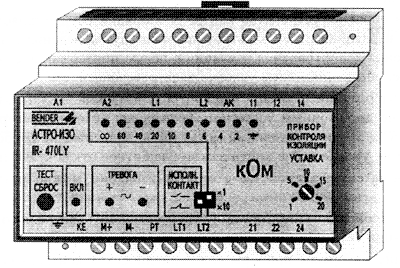12. Insulation monitoring, fault detection it
mains operation mode, isolated from the ground (the mode of an isolated neutral, IT-System), widely used in electrical systems that require high reliability of power supply, and osoboopasnyh by electrocution conditions. These electrical installations include the power supply system of medical institutions, hospitals, ships, railway companies, mining, petroleum, steel, chemicals, test, laboratory, explosive production and many others.
In electrical networks and electrical isolated from the ground, the conditions of electrical safety and reliability of power supply to a large extent determined by the state of isolation, its resistance and capacitance with respect to ground. In order to ensure the required level of insulation resistance in electrical network or a specific electrical installation regulations require maintaining a continuous automatic control (monitoring) Insulation resistance carried out by the insulation monitoring device.
As these networks of electrical conditions may be provided with a high insulation resistance, the use of an RCD is not always justified, although in some cases it may be necessary.
insulation monitoring device functions of the insulation resistance measurement networks under operating voltage and current collectors included the evaluation of measuring results by comparison with the setpoint defined by, as a rule, on electrical conditions, and, if necessary, the alarm is turned on or the impact on the breaking device.
Thus, the insulation monitoring device provides "human chain protecting electrical insulation" by maintaining continuous measurement of insulation resistance in order to maintain its value at a level that provides electrical conditions.
The foregoing means that the insulation monitoring is necessary but not sufficient condition for the provision of electric conditions. Sufficient conditions are: the maintenance of insulation resistance at a level above the critical, safety shutdown, etc.
By appointment of the insulation monitoring device can be divided into groups:
A - automatic devices (continued) Insulation resistance monitoring network or set relative to the ground;
B - an inspection equipment for periodic control measurements of the insulation resistance in the working mode of the network;
B - selective detection device in branched networks of electrical connection (feeder) with reduced insulation resistance.
Currently in Russia and abroad are issued insulation monitoring device, which differ from each other the principle of action, constructive solutions, applications, working reliability.
The leading position in the field of production takes German firm Bender GmbH, which has branches and subsidiaries in many countries - the United States, Brazil, France, Slovakia, South Korea and others.
This company production program includes the insulation monitoring device for AC networks with voltage up to 690 V DC networks up to 500 V, mixed (AC and DC), disconnected (included periodically), the search unit damaged connections (feeder) for large networks AC voltage up to 10 kV DC to 690 V, and others.
A special place in the program is installing a redundant power supply of medical institutions, such as operating rooms and extreme care.
The Russian company has mastered the production of the SCR MEI licensed firm Bender GmbH automatic insulation monitoring device "ASTRO-ISO-470", with the following technical parameters:
Rated operating voltage 0-690 In
AC Frequency 50-60 Hz
Setting ranges for insulation resistance, 1-20 and 10-200 ohm
Alarms, on the scoreboard and remote
The number of pairs of contacts of the relay, 2
Execution, shield, DIN-rail mounting
Appearance and connection diagrams are shown in Fig. 12.1 and 12.2.

Figure 12.1. Exterior insulation monitoring device ASTRO-Arts 
Figure 12.2. insulation monitoring device Connection diagrams ASTRO-Arts
Important is the choice of setting the automatic insulation monitoring devices. Setpoint selection is carried out in terms of electrical safety or sustainable average level of insulation resistance of the network relative to the ground.
One of the most time-consuming and difficult activities in the practice of operating networks with isolated neutral is to identify the feeder with reduced insulation resistance. There is a class of devices (RCM - residual current monitor - residual current monitoring device), stationary, with current sensors on the accessions and portable, as tokoiskatelnyh ticks, allowing for the selective control of insulation.
Selective (selective) called the action of the protective device, providing only off the damaged part of the network element or by electrical switches next to it. selectively disable attachments algorithm should be made taking into account the configuration of networks, their branching, a category of power supply, etc.
The principle of selectivity of action of electric devices can be formulated in the form of two conditions - a necessary and sufficient.
A necessary (but not sufficient) condition for the selectivity of action of the device is the presence of each of the controlled object (an electric circuit) sensor, which controls the state of the resistance of its insulation.
A sufficient condition for the selectivity is the selection of an optimal algorithm poll sensors and commands to disable devices.
As an example, search for devices damaged joining in branched networks of AC voltages up to 10 kV, with earth systems TN or IT device can lead RCMS-470 above the production company "Bender", which allows continuous monitoring of leakage current in 12 feeders at the same time. For each feeder corresponding differential current setpoint can be set. The output signal from the device can be fed either to the signaling device or on the executive devices - switches.


Comments
Commenting, keep in mind that the content and the tone of your messages can hurt the feelings of real people, show respect and tolerance to his interlocutors, even if you do not share their opinion, your behavior in terms of freedom of speech and anonymity offered by the Internet, is changing not only virtual, but real world. All comments are hidden from the index, spam control.